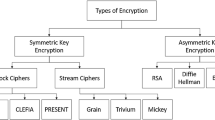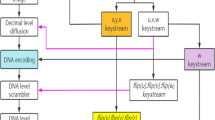Abstract
To enhance the security of H.264/AVC streaming, such as that for Internet protocol television, over a passive optical network (PON), a dynamic reconfigurable coding–decoding scheme, based on a chaotic sequence, was demonstrated and characterised by pseudo randomness and a maximal period. Compared with conventional optical code-division multiple-access (OCDMA) PONs, without providing a dynamic reconfigurable mechanism and trigger timing, a secure mechanism was generated using a proposed chaos/maximal length sequence (M-sequence) mapping algorithm and embedded in a codebook to control an electrical controller (register). Because the state of the electrical controller (register) is used by the chaos/M-sequence mapping time sequence pattern to trigger a switch matrix and then vary the M-sequence signature address code for each authorised user, the scrambling and interleaving function of the encryption scheme was implemented in the OCDMA-PON physical layer for various M-sequence signature address codes to carry individual H.264/AVC transmissions of the same channel. The proposed chaos/M-sequence mapping algorithm provided similar pseudo randomness and higher variance effectiveness compared with a general uniform distribution of the pseudo-random, autocorrelation, and cross-correlation properties of the proposed time sequence. In addition, the scrambling and interleaving efficiency was determined to be sufficiently high by the reduced peak signal-to-noise ratio of encrypted videos and the produced unidentifiable videos for unauthorised users.












Similar content being viewed by others
References
Chang Y-T, Sue C-C, Huang J-F (2007) Robust design for reconfigurable coder/decoders to protect against eavesdrop-ping in spectral amplitude coding optical CDMA networks. IEEE J Lightwave Technol 25(8):1931–1948
Chen Y, Cheng J (2011) Research on the security protection based on spatiotemporal chaos technology for the video resource of network education. IEEE ITME Int Symp 1:276–279
Cheng H, Li X (2000) Partial encryption of compressed images and videos. IEEE Trans Signal Process 48(8):2439–2451
Devaney R (1989) An introduction to chaotic dynamical systems, 2nd edn. Addison-Wesley, Redwood City
Dixit S IP over WDM: building the next-generation optical internet. John Wiley and Sons, Inc., New Jersey, page 2003
Dufaux F, Ebrahimi T (2008) Scrambling for privacy protection in video surveillance systems. IEEE Trans Circuits Syst Video Technol 18(8):1168–1174
Etemadi Borujeni S, Ehsani MS (2015) Modified logistic maps for cryptographic application. Appl Math 6:773–782
Frey R (1993) Chaotic digital encoding: an approach to secure communication. IEEE Trans Circuits Syst 40:660–666
IEEE 802.3ah Ethernet in the first mile task force. Available from http://www.ieee802.org/3/efm/
Karafolas N, Uttamchandani D (1996) Optical fiber code division multiple access networks: a review. Opt Fiber Technol 2(2):149–168
Kavehrad M, Zaccarin D (1995) Optical code-division-multiplexed systems based on spectral encoding of noncoherent sources. IEEE J Lightwave Technol 13:534–545
Kim KS (2003) On the evolution of PON-based FTTH solutions. Inf Sci 149/1-2:21–30
Kitayama K, Wang X, Wada N (2006) OCDMA over WDM PON—Solution path to gigabit-symmetric FTTH. J Lightwave Technol 24(4):1654–1662
Kocarev L, Lian S (eds) (2011) Chaos-based cryptography-theory, algorithm and application. Springer, Heidelberg
Kramer G, Pesavento G (2002) Ethernet passive optical network (EPON): building a next-generation optical access network. IEEE Commun Mag 40:66–73
L-f H, Zhang G, Z-s T (2010) A chaotic secure communication scheme based on logistic map. IEEE ICCASM Conf 8:v8-589–v8-591
Li TY, Yorke JA (1975) Period three implies chaos. Am Math Mon 82(10):985–992
Marhic SV, Kostic ZI, Titlebaum EL (1993) A new family of optical code sequences for use in spread spectrum fiber-optic local area networks. IEEE Trans Commun 41(8):1217–1221
Massoudi A, Lefebvre F, De Vleeschouwer C, Macq B, Quisquater J-J (2008) Overview on selective encryption of image and video: challenges and perspectives. EURASIP J Inf Secur 2008, 179290, 18 pages
May RM (1976) Simple mathematical models with very complicated dynamics. Nature 261(5560):459–467
Pareek NK, Vinod P, Sud KK (2006) Image encryption using chaotic logistic map. Image Vis Comput 24(9):926–934
Salehi JA (1989) Code division multiple-access techniques in optical fiber networks—Part I: fundamental principles. IEEE Trans Commun 37(8):824–833
Shake TH (2005) Security performance of optical CDMA against eavesdropping. IEEE J Lightwave Technol 23(2):655–670
Shake TH (2005) Confidentiality performance of spectral-phase-encoded optical CDMA. IEEE J Lightwave Technol 23(4):1652–1663
Sühring K (2009) H.264/AVC Reference Software Group [On-line]. Available: http://iphome.hhi.de/suehring/tml/, Joint Model 12.2 (JM12.2)
Wiegand T, Sullivan GJ, Bjontegaard G, Luthra A (2003) Overview of the H.264/AVC video coding standard. IEEE Trans Circuits Syst Video Technol 13(7):560–576
Acknowledgments
We thank Mr. Chung-Wei Tsailin, Yen-Chung Huang, and Wei-Hsiang Wang for providing information related to the experiments and simulations.
Author information
Authors and Affiliations
Corresponding author
Rights and permissions
About this article
Cite this article
Chang, YT., Lin, YC. Dynamic reconfigurable encryption and decryption with chaos/M-sequence mapping algorithm for secure H.264/AVC video streaming over OCDMA passive optical network. Multimed Tools Appl 75, 9837–9859 (2016). https://doi.org/10.1007/s11042-015-2784-1
Received:
Revised:
Accepted:
Published:
Issue Date:
DOI: https://doi.org/10.1007/s11042-015-2784-1




